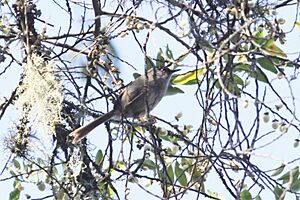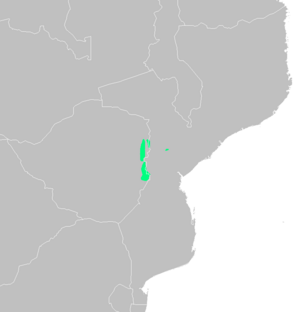Roberts's warbler facts for kids
Quick facts for kids Roberts's warbler |
|
|---|---|
 |
|
| Conservation status | |
| Scientific classification | |
| Genus: |
Oreophilais
|
| Species: |
robertsi
|
 |
|
| general range: the montane forest-grassland mosaic | |
| Synonyms | |
|
|
The Roberts's warbler (Oreophilais robertsi) is a small bird. It is also called the Roberts' prinia, briar warbler, or brier warbler. This bird is a type of passerine bird, which means it's a perching bird. It belongs to the family called Cisticolidae.
This special bird lives only in the Eastern Highlands of Zimbabwe and Mozambique. It likes to live in warm, wet montane forests and subtropical or tropical moist shrublands. The Roberts's warbler is the only species in its group, called Oreophilias.
Contents
About the Roberts's Warbler Name
The Roberts's warbler was first officially described in 1946. A British bird expert named Constantine Walter Benson gave it the name Prinia robertsi. However, it was first noticed as a new species back in 1906 by Charles Swynnerton.
Later, in 1991, another expert named Phillip Clancey suggested a new group for this bird. He called it Oreophilias. He did this because the Roberts's warbler has 8 tail feathers. Other birds in the Prinia group have 10 tail feathers.
The Roberts's warbler is part of the Cisticolidae family. This family includes many small "African" warblers. These birds were once thought to be part of the Old World warbler family.
What the Name Oreophilais Means
The name Oreophilais has a special meaning. It comes from two Greek words. Oreophil means "mountain-loving." Lais comes from hypolais, which is a name for a small songbird.
The second part of its scientific name, robertsi, honors a South African bird expert. His name was Austin Roberts. This was to thank him for his important work on birds in southern Africa.
What Roberts's Warbler Looks Like
The Roberts's warbler looks a bit like other birds in the Prinia group. They are small, warbler-like birds with long tails. But the Roberts's warbler is different because it has 8 tail feathers, not 10. Its tail also looks more "stepped" than the smooth tail of a Prinia.
This bird is mostly dark grey. It looks most like the tawny-flanked prinia. But the Roberts's warbler has a grey throat and pale eyes. It also doesn't have brown edges on the feathers of its upper body.
The top of its head and the rest of its upper body are dull olive-brown. Its wing feathers are dark brown, and its tail is brown. The underside of its body is grey to reddish-grey. These parts become paler when it's not breeding season. Young birds have dark eyes. The Roberts's warbler is about 13 to 14 cm (5.1 to 5.5 in) long.
Where Roberts's Warbler Lives
The Roberts's warbler lives only in the Eastern Highlands of Zimbabwe. You can find it from the Chimanimani Mountains in the south to Nyanga in the north. It usually lives at high places, above 1,200 m (3,900 ft). In these areas, it seems to take the place of the tawny-flanked prinia.
Its home also reaches into parts of Mozambique. But it has not been seen on Mount Gorongosa. It prefers forests along streams and open areas. It also likes thick patches of bracken, Erica plants, and briar (Smilax) plants at the edges of forests.
Roberts's Warbler Behavior and Life Cycle
You can often see Roberts's warblers in small groups. These groups can have up to 10 birds. They look for food on the lower branches of trees, among bracken and briars. These groups often stop to "chatter" together. They stay in touch with a repeated call that sounds like "nyerk-nyerk-nyerk." They also make buzzing sounds. These sounds are a bit like a babbler's calls, but not as rough.
This bird eats insects. It might look for food alone, in groups, or with other types of birds. It has been seen eating flies, beetles, and grasshoppers.
Reproduction and Nesting
Roberts's warblers breed between September and February. Most eggs are laid in September. Their nest is shaped like an oval. It has an entrance near the top. The nest is made from fine grasses and moss. It is held together with spider webs. Nests are usually about 1 m (3 ft 3 in) above the ground.
A female bird usually lays 2 or 3 eggs. The eggs are turquoise with brown and lilac spots.
Conservation Status
The Roberts's warbler is listed as a species of Least Concern by the International Union for Conservation of Nature. This means it is not currently in danger of disappearing. Even though it lives in a small area, its population seems to be stable. Experts believe there are enough of these birds to keep them off the endangered list.


